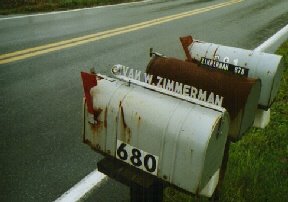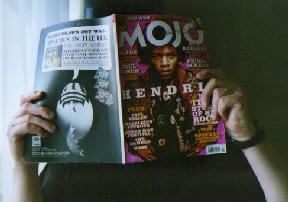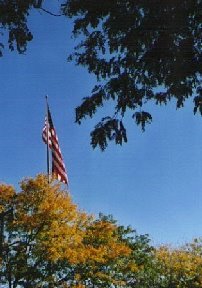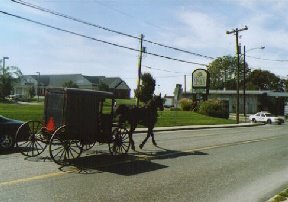
Dear Chroniclers,
as you will have gathered from earlier pastings, our American adventure took place in Pennsylvania, temporal home to one of the largest Amish communities in the world.
We were very fortunate indeed to have not one, but two marvellous tour guides who know the community well. Accordingly we were granted access to places that would not normally feature on the tourist map.
Set out below is the verbatim text from some furious scribblings made at the back of the tour bus during the course our first visit to the Amish. These record a few basic points concerning their history and culture which I hope may enable you to make sense of later pastings as the story unfolds.
best regards
electrofried (mr)
About the AnabaptistsThe Amish are
anabaptists, a Christian movement that believes in adult baptism through informed choice, rather than by proxy during infancy. Their roots lie in the Protestant reformation of the sixteenth century and their spiritual heritage dates back to the origins of Christianity.
Many similarities can be seen with the early church, in particular the emphasis on sound teaching, close fellowship and a simple, humble approach to living out the Christian life. An oft-quoted passage from scripture encapsulates this perfectly:
"What does the Lord require of you, but to do justly, and to love mercy, and to walk humbly with your God"(Micah6:8)
Division and DevelopmentOver time, the
anabaptist movement has been subject to many divisions and developments. One of the most significant occured in 1536 when a Catholic priest from the Netherlands called, Menno Simmons, joined the movement.
His leadership helped bring together a number of scattered
anabaptists who soon became known as Mennonites.They went on to spread out across Europe and, to this day, retain strongholds in Georgia and the Ukraine. The Menonnites continue to place great store on pacifism.
In many ways the Menonnites are similar to the Amish, and often live side-by-side with their more conservative "cousins".
The Amish
The Amish are yet another branch of the
anabaptist movement. They began life in 1693 under the guidance of Jacob Amman, a young Swiss Mennonite leader. Jacob was concerned about the growing liberalism within the wider
anabaptist movement.
He had a more conservative approach to faith and ended up establishing a new division of
anabaptism. As with the Mennonites, this branch took on, in time, the name of its leader. Accordingly, its followers became known as the Amish.
Under AttackAs the seventeenth century began, the new Amish communities came under increasing threat. They were widely persecuted in Europe and many of their leaders were put to death. Their communities sustained further damage as a consequence of both the intercenine wars that beset Europe during this period and the famines that followed.
But a way out was offered ...
William PennWilliam Penn, like many other Christian non-conformists, was subject to religious persecution, ending up at one point in the Tower of London. He was a Quaker, committed to change through peaceful means.
Fortunately, William was related to Admiral Penn.
The Admiral was a supporter of the royals during a time of struggle in the UK. King Charles I was indebted to him as a consequence - however, rather than repaying in money, the King elected instead to settle the debt by donating several large tracts of land in America. These eventually ended up in the hands of William Penn.
Formation of a new StateWilliam was a visionary thinker who believed people could live in a state of peace and harmony despite having different religious convictions. He was determined to put these beliefs in practice, and therefore, as a grand
"Holy Experiment" opened up his new possessions in the States to all who shared his views.
The Amish were quick to take up his offer of free land and the flight to America began in earnest around 1720. Significant numbers of European Amish left from the port of Rotterdam in Holland and set sail across the Atlantic to Philadelphia.
Following their arrival, many of them journeyed to what is now known as the County of Lancaster some 60-70 miles from Philadelphia. Previously Lancaster was inhabited only
by a few British settlors. It now houses one of the largest Amish communities in the world.
The growth of the Amish communityThe new immigrants discovered a rich, fertile farmland in Pennsylvania which continues to this day to deliver the highest rate of agricultural production in the States.
In time, the Amish spread - they have now established communities in twenty-two US States together with the Canadian State of Ontario. The County of Lancaster remains a stronghold and some 150,000 Amish now live there.
On average, each Amish family has seven children and their numbers continue to grow. Unfortunately, as land becomes scarce, this means that many can no longer become farmers, the long-standing occupation of choice for the Amish. Instead, they have turned their hands to work as bakers, carpenters, dealers and repairers of agricultural machinery, builders and the like.
Amish dress - FemaleThe Amish have a distinctive dress and are known as the
"plain people" for good reason.
Amish women wear a plain dress in the colour of their choice, usually increasingly muted as they grow older. Over this they wear a black pinafore, fastened either with flat pins or press-studs (known in the States as "snaps"). Buttons are regarded as frivolous. Accordingly they are either not used at all or are added in matching colour to make them inconspicuous.
Younger children will wear only the dress in Summer, but come the Winter they too will add a pinafore for warmth.
Amish girls are normally bare-headed, but as they approach teenage years will wear a blue bonnet on formal occasions. On becoming teenagers this changes to black - and, in due course, if they marry, to white.
The bonnet reflects the religious conviction of the Amish, which stems from a passage in Paul's first Letter to the Corinthians, that a woman's head should be covered when she is in prayer. As their life is an ongoing prayer the bonnet is worn at all times.
The outfit is completed by black stockings and plain black shoes - though Amish children are permitted a slightly more liberal regime. Come Summer they usually go barefoot - and some will wear trainers rather than shoes.
Amish females never cut their hair. There is but one hair-style - a parting down the middle with the hair tied back in a bun to one side. They wear neither make-up nor jewellry.
Amish dress - MaleMale attire is equally sombre - a plain black jacket and matching trousers, a white or self-coloured shirt and black shoes. Men, too, have prescribed headwear - in Summer a straw hat and in Winter a black felt hat. The hat is worn at all times in public - though the definition of "public" is somewhat narrower than ours.
Amish culture does not permit the use of zips. Accordingly the trousers have a flap at the front fastened by four buttons in two matching pairs - these are known as broad-fronted button-drop pants.
A relatively recent innovation has been the use of denim in clothing for farm-work.
Amish men are clean-shaven until the day they marry. They then cease shaving and grow a beard, but
not a moustache. As with Amish women, individuality in dress is actively discouraged. The Amish derive much comfort from wearing a shared "uniform" that helps foster the community spirit that lies at the heart of their culture.
TransportThe Amish steer well clear of cars. They believe this method of transport will tempt then to journey away from the community to which they hold dear. Accordingly, transport is by means of horse and carriage, a frequent sight on the streets of Lancaster. They also avoid the use of rubber wheels - wood or iron is used instead.
SchoolingThe Amish have established separate schools for their children, and these are recognised by State law. Teaching usually takes place in a single classroom with a young female teacher in charge.
State law also exempts the Amish from continuing in education beyond the age of fourteen. Instead, they learn vocational skills by working alongside their parents.
The Amish do not go on to higher education, though this has not affected either the sustainablility or prosperity of their community. Their services and products are much in demand and they are far more integrated into mainstream commercial life than may at first be believed. Amish furniture, in particular, is on sale throughout the east of America.
Religious structuresThe Amish worship at home, rather than in churches - though a recent breakaway group, the Church Amish, are starting to construct permanent church buildings.
The Amish are organised into geographical districts, each comprising twenty-five families. Every district will have a deacon (who looks after administrative matters) and two ministers responsible for taking the Services and pastoral care.
There will be a bishop for each eight districts. The bishop is responsible both for administering the sacraments and for deciding the rules and regulations that determine day-to-day Amish life.
ServicesServices take place once a fortnight and last up to three and a half hours. Often in Summer they take place in barns to avoid the stifling heat.
The Amish use the Martin Luther Bible translation and a traditional song-book called the
Ausbund that is several centuries old.
"Hoch deutsch" or "high German" is used throughout the Service.
The songs sound much like chants and there are two sermons. The first opens the Service and lasts twenty to thirty minutes. The second, and longer, sermon lasts between one to one and a half hours. In addition there are prayers (for which everyone kneels) and the reading of the Scriptures (for which everyone stands).
At the end of the Service there will be a fellowship meal. The elders eat first, the children eating later out of respect. Once the meal is over the elders will stay on in the house whilst the younger members of the congregation go outside for games, often meeting up with the youth from other, neighbouring districts. This often where young couples will get together.
Finally, everyone will get together again for a second meal, followed by singing, a favourite pastime for the Amish.
MarriageMarriages are not arranged in the Amish community - indeed, there are safe-guards in place to make sure young Amish are not put under any parental pressure. The wedding itself takes place in the home and is on a large scale - two to three hundred guests is not unusual.
Once the couple are married the barn-building team sets to work. Unfortunately, as a consequence of the scarcity of land, it is no longer possible for every Amish couple to have their own farm. However, the barns are usually built close to the parents.
The barn-building team will consist of sixty to seventy men with specialist skills, supported by an equal number of women to cook and cater for the menfolk whilst they are at work. This community spirit is extended to the wider population. If a neighbour's barn blows down the Amish will provide a builiding team free of charge, leaving the owner just to meet the cost of the materials. The Amish believe this is part of their general community duty.
BaptismThe concept of adult believer baptism with informed choice is central to all
anabaptists, of whom the Amish are a branch.
Accordingly, baptism will take place no earlier than age sixteen - the usual age being between eighteen and twenty-five. Contrary to popular belief the baptism is carried out by the simple pouring of water on the head - there is no requirement for full immersion.
Until baptism young people are not formally part of the Amish community. Accordingly, they enjoy much greater freedom than might be expected. Again, contrary to popular belief, there is no "year out" in the wider world - the individual always retains the choice as to which path to follow.
Of course, Amish children like all others will rebel against their parents. However, a very high proportion do indeed make the choice to join the community - recent estimates place the numbers making this choice at between 90 - 95%.
FuneralsWhen an Amish person dies the body will be taken first to an undertaker for embalming. It will then be brought back to the home for an official wake lasting two days. The funeral then takes place on the third day.
The design of the coffin is prescribed and the body is dressed in white to symbolise freedom from sin. The Amish do have graveyards and on the occasion of a funeral a special place will be made available for horses and carriages.
The Outside WorldThe Amish call everyone outside their community,
"English", regardless of where they hail from. The outside world is viewed with some suspicion - the Amish follow a strict biblical model of being in, but not of, this world.
That said, there is far more integration than may first be thought. The Amish are increasingly involved with commercial activity that brings them in contact with the wider world. However, there are some things they continue to avoid - the most obvious of which is electricity.
Whilst they are happy to use batteries (and a torch is usually to be found on the bedside table) the Amish do not wish to be connected to the rest of the world on a permanent basis. They believe this will introduce too many worldly temptations. Accordingly, Amish homes remain free of computers, televisions, DVD players and other similar devices. They will also be illuminated by portable gas-lights rather than electricity.
Telephone usageFor similar reasons, the Amish will not have a telephone in the house - they believe this will disrupt the peace of family life. However, they will use the telephone. Normally it will be a communal facility, the telephone being housed in an outside shed. The monthly bill is then split between the participating families in accordance with usage.
LanguageAll Amish speak three languages - low German for everyday conversation, high German for Services and English for communicating with the outside world.
A typical Amish houseAmish houses are far less spartan than may be imagined. Whilst the style is simple, it is by no means austere or unattractive.
There are no photographs or paintings of family members - the Amish pay strict adherence to the Biblical command not to make graven images. Instead, they will often have brightly coloured family records displayed on the wall. This may be supplemented by calendars containing appropriate images and greeting cards.
Whilst there are no large vanity mirrors, the Amish do have small mirrors for grooming purposes. Houses have no central heating - what heat there is will be provided by the kitchen range. For this reason, the parents bedroom is normally downstairs closest to the warmth.
Traditionally, babies are kept in cribs in the parents' bedroom to assist the process of bonding. Older Amish view with some suspicion a growing practice amongst certain younger Amish to have nurseries.
The bathroom facilities will also be downstairs for reasons of practicality, the water being gravity-fed from water-towers. The kitchen will contain either a tradional range or a cooker powered by Calor gas. A recent innovation is the introduction of gas-powered refrigerators, which are readily available in the States as a consequence of the popularity of motorised homes.
Food in the kitchen will be mostly tinned or preserved. Few Amish today are totally self-sufficient and they do visit supermarkets to stock up. The likes of Walmart are keen to attract Amish custom and have even gone so far as to build special sheds to shelter their carriages and horses whilst they are shopping in the store.
The children's bedrooms will be upstairs. Boys rooms tend to be more austere than girls - the most decoration of all being reserved for teenage and older females. They may even be permitted simple curtains in addition to the traditional green window-blinds.
Amish children do play with toys, though clearly not computer games, TV sets, DVD and CD players etc.
 Dear Chroniclers,
Dear Chroniclers,














